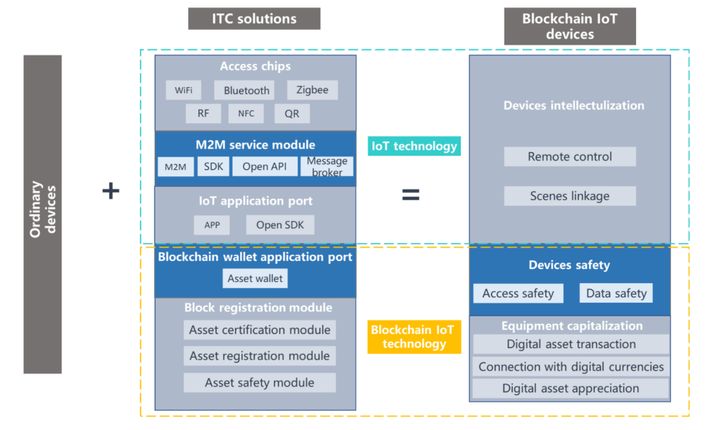Co-authored by Sherman Lee and Josef Hazi.
At the time of this writing, the trading volume of IoT Chain (ITC) is $72M with a market cap of $106M. A trading volume of 67% of market cap is what caught my eye to dig in further on what was quietly happening with this little known project in China.

The Internet of Things (IoT) is a network of correlated computing devices, mechanical and digital machines, objects, as well as other items that have unique identifiers which allows them to share and exchange data within the existing internet infrastructure. This data is then used to improve their performance.
Imagine taking the components that make up a smart phone and implementing them in other objects, such as a 3D printer, thus making these objects “smart.” Smart 3D printers could gather data of successful and unsuccessful printing protocols of turbine blades via embedded sensors and chips. This data would then processed by a simple computer and subsequently shared with other smart machines via wifi or broadband connection; there is no need for any human-computer interaction. Real world applications of IoT can be found in machine-to-machine communication, healthcare, building management, smart energy grids, precision agriculture, wearable electronics, transportation, and many others.
According to Weber’s and Zeigeldorf’s studies, adoption of IoT is subject to overcoming challenges regarding data privacy, data sovereignty, and security. Tanuj Mohan stated on Forbes, “Traditional internet security is still important for the IoT, but it does not go far enough. Designing proper authentication, authorization, accounting, encryption, intrusion detection, software signing and trust models promotes interaction between devices that are online. A security flaw can present an imminent physical threat to the user.” An operating system based on a blockchain (or a DAG) technology could solve these issues.
The Internet of Things is a key driver in the Fourth Industrial Revolution. The global market of IoT hardware spending is fast growing and has reached $1.7 trillion, with IoT services reaching $300 billion. Based on the current year-on-year growth of 30%, Gartner predicts the IoT hardware spending will reach $3 trillion by 2020.
According to their website, the IoT Chain team is working on an operating system for IoT devices that is lite and high security. It is an IoT blockchain that scales to >10k txn/sec, giving an average transaction confirmation speed in the millisecond range.
With over 20 billion IoT units installed out in the wild and in use by 2020, IoT Chain can protect those devices from being attacked by hackers and ensure privacy of that data. Devices running the IoT Chain technology will not be compromised by botnet attacks.
As an artificial intelligence and machine learning practitioner, there’s something else about IoT Chain that gets me super excited; the data being collected by those devices enable a data ecosystem. Any company that wants to access that data can create a smart contract (ChainCode in their terms), pay the IoT device owner with tokens, and leverage the data for machine learning.
Artificial intelligence projects like Raven Protocol (which I’m working on with some of the brightest minds in AI) and SingularyNET would not hesitate to integrate data from IoT Chain into their own ecosystem.

Architecture of IoT Chain Platform
PBFT Consensus Protocol - IoT Chain applies PBFT (Practical Byzantine Fault Tolerance) consensus algorithm to achieve main chain consensus. This greatly improves the main chain’s processing performance on the premise of achieving consensus of main chain’s decentralization.
DAG Network - IoT Chain adopts DAG’s (Directed Acyclic Graph) data structure to solve performance problems. This vastly improves transaction performance. It also can resist a quantum attack. IoT Chain applies distributed PoW and PoS methods. Each IoT device can use a different security level depending on their security requirements in the IoT ecosystem.
SPV Technology - Nodes in IoT Chain use SPV (Simple Payment Verification). This conducts payment verification without maintaining complete blockchain information. All that is required is that the blocks’ headers are preserved. IoT Chain uses SPV technology to solve the data expansion problem of major networks and DAG. The efficiency gain is the key to ensuring the entire network’s performance.
Secure Data Analysis - Large amounts of data will be generated on IoT devices. IoT Chain will become a data ecosystem. Any company who wants to do data analysis for AI training, optimizing ad campaigns, etc., will need to submit ChainCode to IoT Chain. Once the ChainCode executes, the companies automatically pay ITC token to users who provided the data.
CPS Cluster - CPS (Cyber Physical System) is a multi-dimensioned smart technical system based on big data, the network, and mass computation. CPS will integrate communications of computing between physical space and cyberspace involving the object’s mechanism, environment and community.
Table taken from their white paper:

White Paper: https://iotchain.io/pdf/ITCWHITEPAPER.pdf
Website: https://iotchain.io
Twitter: https://twitter.com/IoT_Chain
Telegram: https://t.me/IoTChain
Sherman Lee writes and lives in the future by getting his hands dirty in the latest advancements of blockchain, crypto, and artificial intelligence. Founder at RavenProtocol.com and Rocco.AI. Editor-in-chief for The Front Page of Deep Tech. Interested in decentralized and distributed deep learning? Sign up and earn 100 FREE Raven tokens!
